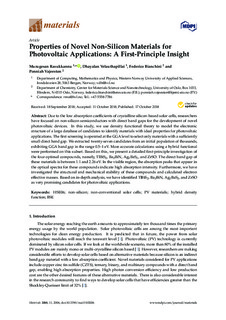| dc.contributor.author | Rasukkannu, Murugesan | |
| dc.contributor.author | Velauthapillai, Dhayalan | |
| dc.contributor.author | Bianchini, Federico | |
| dc.contributor.author | Vajeeston, Ponniah | |
| dc.date.accessioned | 2019-01-11T09:22:54Z | |
| dc.date.available | 2019-01-11T09:22:54Z | |
| dc.date.created | 2018-11-16T20:26:01Z | |
| dc.date.issued | 2018 | |
| dc.identifier.citation | Rasukkannu, M., Valauthapillai, D., Bianchini, F., & Vajeeston, P. (2018). Properties of novel non-silicon materials for photovoltaic applications: A first-principle insight. Materials, 11(10), 1-17. | nb_NO |
| dc.identifier.issn | 1996-1944 | |
| dc.identifier.uri | http://hdl.handle.net/11250/2580288 | |
| dc.description.abstract | Due to the low absorption coefficients of crystalline silicon-based solar cells, researchers have focused on non-silicon semiconductors with direct band gaps for the development of novel photovoltaic devices. In this study, we use density functional theory to model the electronic structure of a large database of candidates to identify materials with ideal properties for photovoltaic applications. The first screening is operated at the GGA level to select only materials with a sufficiently small direct band gap. We extracted twenty-seven candidates from an initial population of thousands, exhibiting GGA band gap in the range 0.5–1 eV. More accurate calculations using a hybrid functional were performed on this subset. Based on this, we present a detailed first-principle investigation of the four optimal compounds, namely, TlBiS2, Ba3BiN, Ag2BaS2, and ZrSO. The direct band gap of these materials is between 1.1 and 2.26 eV. In the visible region, the absorption peaks that appear in the optical spectra for these compounds indicate high absorption intensity. Furthermore, we have investigated the structural and mechanical stability of these compounds and calculated electron effective masses. Based on in-depth analysis, we have identified TlBiS2, Ba3BiN, Ag2BaS2, and ZrSO as very promising candidates for photovoltaic applications. | nb_NO |
| dc.language.iso | eng | nb_NO |
| dc.publisher | MDPI | nb_NO |
| dc.rights | Navngivelse 4.0 Internasjonal | * |
| dc.rights.uri | http://creativecommons.org/licenses/by/4.0/deed.no | * |
| dc.subject | HSE06 | nb_NO |
| dc.subject | non-silicon | nb_NO |
| dc.subject | non-conventional solar cells | nb_NO |
| dc.subject | PV materials | nb_NO |
| dc.subject | BSE | nb_NO |
| dc.subject | hybrid density function | nb_NO |
| dc.title | Properties of novel non-silicon materials for photovoltaic applications: A first-principle insight | nb_NO |
| dc.type | Journal article | nb_NO |
| dc.type | Peer reviewed | nb_NO |
| dc.description.version | publishedVersion | nb_NO |
| dc.rights.holder | © 2018 by the authors. | nb_NO |
| dc.subject.nsi | VDP::Teknologi: 500::Materialteknologi: 520 | nb_NO |
| dc.source.pagenumber | 1-17 | nb_NO |
| dc.source.volume | 11 | nb_NO |
| dc.source.journal | Materials | nb_NO |
| dc.source.issue | 10 | nb_NO |
| dc.identifier.doi | 10.3390/ma11102006 | |
| dc.identifier.cristin | 1631590 | |
| cristin.unitcode | 203,2,30,0 | |
| cristin.unitname | Institutt for data- og realfag - Bergen | |
| cristin.ispublished | true | |
| cristin.fulltext | original | |
| cristin.qualitycode | 1 | |

